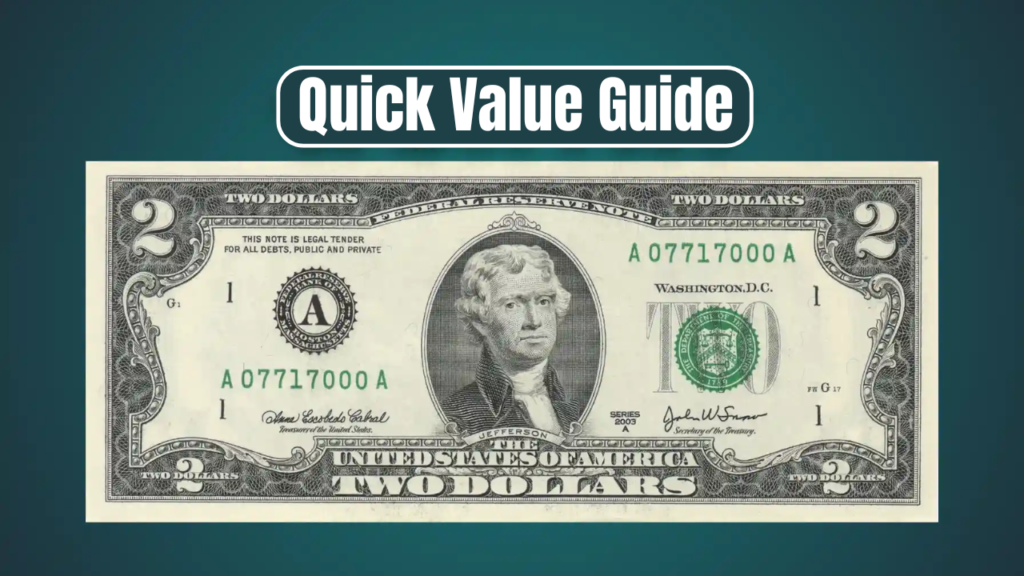Introduction
The $2 bill is one of the most fascinating and often misunderstood banknotes in U.S. currency. While many people assume they are rare, some $2 bills are worth significantly more than their face value due to unique characteristics. But how can you tell if your $2 bill is valuable? Here, we explore seven key factors that determine the worth of a $2 bill and how you can assess its rarity.
1. Year of Issue
One of the first things to check on a $2 bill is the series year printed on it. Certain years are more valuable due to lower production numbers or historical significance.
Notable Valuable Series:
- 1862 & 1869: The first $2 bills ever printed, featuring Alexander Hamilton and later Thomas Jefferson.
- 1918: Large-size Federal Reserve Bank Notes with a battleship vignette.
- 1928: First small-size $2 bill featuring Monticello on the back.
- 1953 & 1963: Older red seal notes that collectors seek.
- 1976: The Bicentennial release; some star notes and misprints are valuable.

Quick Value Guide:
| Series Year | Estimated Value (Uncirculated Condition) |
|---|---|
| 1862 & 1869 | $500 – $3,000+ |
| 1918 | $500 – $2,000+ |
| 1928 | $50 – $500+ |
| 1953 & 1963 | $10 – $100+ |
| 1976 | $2 – $50+ |
2. Seal Color & Serial Numbers
The color of the Treasury seal and the serial number format can greatly influence the value of a $2 bill.
- Red Seal (Legal Tender Notes): Issued from 1928 to 1963, these notes can fetch between $10 and $500 depending on condition.
- Green Seal (Federal Reserve Notes): Issued in 1976 and later, they are generally less valuable unless they have unique serial numbers or errors.
- Blue Seal (Silver Certificates): These do not exist for $2 bills, making red and green seals the only options.
3. Star Notes (★) and Special Serial Numbers
If your $2 bill has a star symbol (★) before or after the serial number, it is a Star Note, indicating it was printed as a replacement for defective bills. Star Notes are often rarer and more valuable.
Other Valuable Serial Numbers:
- Low Numbers (00000001 – 00000999)
- Repeating or Palindromes (e.g., 12211221)
- Ladder (e.g., 12345678 or 87654321)
- Birthday or Special Dates (e.g., 07041776 for July 4, 1776)
4. Printing Errors & Misprints
Printing mistakes can dramatically increase the value of a $2 bill. Some of the most valuable errors include:
- Inverted Overprint: The serial numbers and seals are printed upside down.
- Double Printing: Some features appear twice.
- Misaligned Cutting: The bill is off-center or missing parts.
- Missing Ink: Partial or completely missing print elements.
Rare misprints can increase the value of a $2 bill by hundreds or even thousands of dollars!

5. Condition & Grading
Like any collectible currency, condition plays a major role in value. Paper money is graded on a 70-point scale, with higher grades fetching higher prices.
| Grade | Condition Description | Value Impact |
| Uncirculated (65-70) | Crisp, no folds, like new | Highest Value |
| Extremely Fine (40-64) | Minimal folds, bright color | High Value |
| Very Fine (20-39) | Some folds, slight wear | Moderate Value |
| Good (4-19) | Heavy wear, noticeable folds | Lower Value |
| Poor (1-3) | Torn, stained, very worn | Least Value |
6. Limited Print Runs & Low Circulation
Some $2 bill series were produced in lower numbers, making them rarer. Additionally, many people mistakenly believe $2 bills are out of circulation, leading them to hoard them instead of spending them.
Notably, the 1928 and 1953 red seal notes had limited print runs, making them more sought-after.
7. Historical & Collector Demand
Some $2 bills gain value due to collector demand rather than intrinsic rarity. Examples include:
- Bicentennial 1976 $2 Bills: Often sought for nostalgic reasons.
- Bills with postmarks from April 13, 1976: Some banks stamped them with special Bicentennial cancellations.
- Commemorative Sets: Special releases by the U.S. Treasury or collectors’ editions can have increased value.
Conclusion
While not all $2 bills are rare, certain ones can be worth a fortune due to factors like year of issue, seal color, serial number, printing errors, condition, and collector demand. Checking these elements can help you determine if you’re holding a valuable piece of U.S. currency history.
If you have a $2 bill, examine it closely and consider having it appraised by a numismatic expert. Who knows? You might just have a bill worth thousands!
FAQs
1. Are all $2 bills valuable?
No, most modern $2 bills (especially post-1976) are only worth face value unless they have special serial numbers, errors, or are in uncirculated condition.
2. How do I know if my $2 bill is rare?
Check the year, seal color, serial number, and any misprints. If it’s a pre-1963 Red Seal note or has unique features, it could be valuable.
3. Can I still use a $2 bill for purchases?
Yes! $2 bills are legal tender and can be used anywhere in the U.S. However, many people keep them for their novelty or collector value.
4. Where can I sell valuable $2 bills?
You can sell rare $2 bills through coin and currency dealers, auction houses, online marketplaces like eBay, or local collector clubs.
5. Will $2 bills ever be discontinued?
As of now, the U.S. Treasury continues to print $2 bills, though in smaller quantities than other denominations. Their future depends on demand and Treasury policies.



